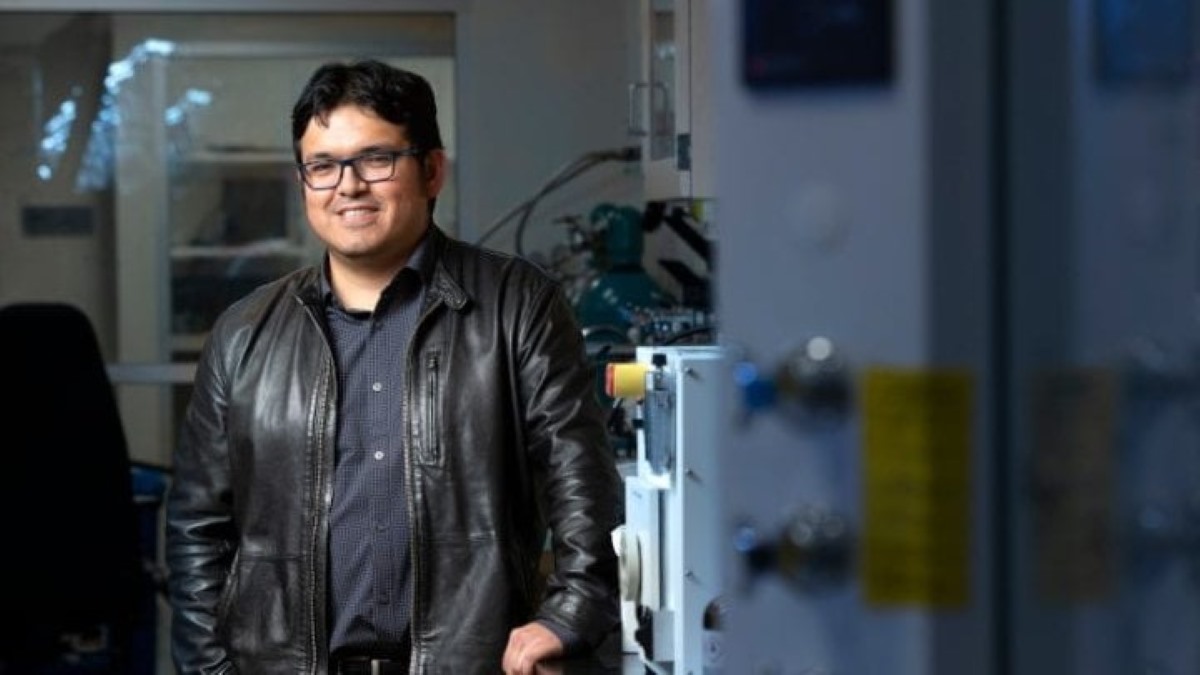A new quantum state of matter has been found in a material which could be useful in building self-charging and deep-space quantum computers.
The phase of matter was independently theoretically predicted by several researchers in the mid-1960s. Its discovery in a lab experiment is published in the journal Physical Review Letters.
“It’s a new phase of matter, similar to how water can exist as liquid, ice or vapor,” says corresponding author Luis A. Jauregui, professor of physics & astronomy at the University of California, Irvine in the US.
Professor Luis Jauregui of the UC Irvine Department of Physics & Astronomy described how the new material he and his lab developed only exists in their labs. Credit: Steve Zylius / UC Irvine.
Experiments done on a unique material, hafnium pentatelluride (HfTe5), showed that it can behave like an excitonic insulator.
Insulators are materials that prevent the conduction of electricity. They do this because there is “band gap” separating electrons in the atom’s filled outer layer from energy levels where conduction can take place.
Excitonic insulators have a gap because of the emergence of excitons. Excitons are not “real” particles in the sense of an electron. They are quasiparticles – objects which behave like particles – formed by a bonded pair of electrons and “holes”.
Holes, too, are quasiparticles. They are the absence of an electron – an absence which can act like a positively-charged opposite of the electron in an atom or material.
The formation of excitons in certain materials, under extreme conditions like very low temperatures and very high magnetic fields, has been shown to form excitonic insulators.
Previous excitonic insulator evidence in other materials has been limited to theoretical work, 2D materials and unconfirmed tests. This is largely because the excitons have been made of electron-hole pairs where the electron and hole have the same spin direction leading to a spin-singlet exciton.
The new HfTe5 excitonic insulator has electrons and holes with opposite spin leading to a spin-triplet exciton.
“Unlike conventional singlet excitonic insulators, the triplet state preserves translational symmetry and is potentially more robust under extreme conditions. This discovery paves the way for exploring emergent spin transport phenomena,” the authors of the study write.
“It’s its own new thing,” says Jauregui. “If we could hold it in our hands, it would glow a bright, high-frequency light.”
Jauregui and colleagues created the new quantum phase of matter by applying a magnetic field of about 70 Teslas in strength. A strong fridge magnet has a magnetic field of about 0.1T and the magnetic field of the Earth is just 25 to 65 millionths of a Tesla.
Another advantage of the HfTe5 excitonic insulator is that, while it requires intense magnetic fields, these are nothing compared to the ultrahigh magnetic fields up to 600T required for some spin-singlet excitonic insulators.
Jauregui says that after the magnetic field was applied, the “material’s ability to carry electricity suddenly drops, showing that it has transformed into this exotic state”.
“This discovery is important because it may allow signals to be carried by spin rather than electrical charge, offering a new path toward energy-efficient technologies like spin-based electronics or quantum devices,” he adds.
The new excitonic insulator isn’t affected by radiation, unlike other candidates.
“It could be useful for space missions. If you want computers in space that are going to last, this is one way to make that happen,” Jauregui says.
